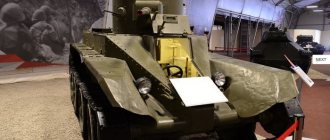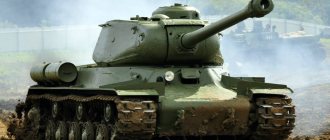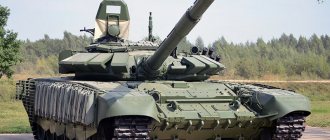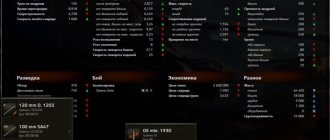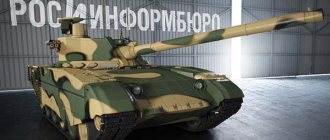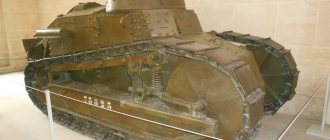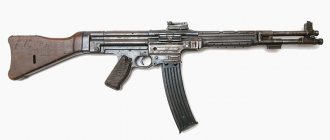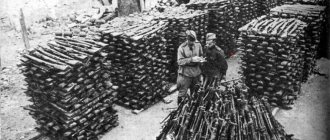Soviet tanks are still considered one of the best examples of armored vehicles in the world. It is not surprising that the Germans, and before them the Finns, actively used them if they managed to get combat-ready war trophies.
Despite the fact that the Red Army had an overwhelming advantage over the Finns, the famous “Winter War” did not end at all as the Soviet command had hoped. In the table below you will see the ratio of losses among manpower and equipment.
Loss table
As you can see, for every Finnish soldier killed, the Red Army paid with at least 4 of its soldiers. But in this article we will talk about what the Finns did with captured Soviet tanks.
T-34
Let's start with the famous T-34, which is considered one of the best tanks of the entire existence of armored vehicles. The Finns managed to capture one of these samples completely intact, without any damage. In total, during the war years, the Finnish army received 7 Soviet “thirty-fours”, 3 of which were handed over to them by the German allies.
First of all, Finnish engineers studied the resulting “trophies”. They highlighted a number of undeniable advantages of the T-34:
- Powerful sloped armor;
- Reliable diesel engine;
- Wide tracks providing excellent maneuverability.
True, the strength of the tracks raised certain questions, as did the visibility of the tank.
T-34, transferred to the Finns by the German allies
Since the T-34 was an excellent representative of Soviet armored vehicles, the Finns trusted such “trophies” only to their most experienced tank crews. The only modification that can be noted is the muzzle brake, which was installed on the 76 mm gun. Otherwise, the tank was used without any significant changes.
Deliveries of infantry fighting vehicles to Finland.
| Number of infantry fighting vehicles delivered to Finland | ||||||||
| Data source | Provider | Year | ||||||
| 1982-1983 | 1988-1989 | 1992 | 1993 | 1994 | 2005 | 2006 | ||
| UN register | USSR | — | — | |||||
| UN register | Russia | 84 BMP-2 | ||||||
| UN register | Germany | 110 BMP-1 | 30 BMP-1 | |||||
| UN register | Czech | 2 BMP-1 | 2 BMP-1 | |||||
| SIPRI | USSR | 40 BMP-1 | 20 BMP-2 | |||||
| SIPRI | Russia | 84 BMP-2 | ||||||
| SIPRI | Germany | 110 BMP-1 | 30 BMP-1 | |||||
| SIPRI | Czech | — | — | |||||
The first batch of BMP-1s from the USSR arrived in Finland in June 1981, the second batch, which included BMP-1K (commander) BMPs, arrived in the summer of 1982, the total number was 40 units. In 1988-89 Finland acquires 20 BMP-2 infantry fighting vehicles from the Soviet Union. In 1992, Finland purchased another 84 BMP-2 from Russia. In 1992-93 110 BMP-1, which were in service with the People's Army of the GDR, were purchased from Germany. Another 30 units. in 1994. During the period 2005-2006. The Czech Republic sold 4 BMP-1s to private collections and museums in Finland.
BT-7
At the time of the “Winter War”, several Soviet BT-7s were at the disposal of the Finns. But there were no specialists in Finland who could understand them, so they were simply dismantled.
The situation changed when the Great Patriotic War began. Only then did the Finnish tankers appreciate all the advantages of the Soviet BT-7 and began to use them for their own purposes. By the summer of 1942, Finnish tank crews were already using more than 50 BT tanks captured from the Red Army as trophies.
Since the Finns were more interested in firepower than in the mobility of light tanks, they decided to convert the BT into self-propelled artillery units. This is how the Finnish self-propelled gun BT-42 was born.
To increase firepower, the gun had to be replaced. The weak 37 mm cannon was replaced with an English gun with a caliber of 114 mm. To compensate for the powerful recoil, a muzzle brake was used. The remaining characteristics of the BT-7 remained unchanged.
Finnish self-propelled gun BT-42 in the museum
Obviously, having assembled one from several different combat vehicles, the Finns could not get an excellent self-propelled gun. BT-42 had a whole range of disadvantages:
- The gun took up too much space inside the turret, depriving the crew of free space.
- The gun turned too slowly because the tracks were not prepared for such conditions of use.
- The English gun itself was only suitable for shelling enemy positions, but could not act effectively against Soviet tanks.
BT-42 performed rather poorly on the Eastern Front. During the battles for Vyborg, the Finns used an entire battalion of such guns, but they could not cause significant damage to Soviet armored vehicles. Soviet T-34s and KV-1s easily outgunned Finnish guns.
Soon the Finns began to use BTs to deliver infantry. Several prototypes of armored personnel carriers were tested in combat conditions, but remained with the engineers. The low-power BT-7 engine could not provide the required speed.
Tanks in the Winter War 1939-1940. (part 4)
<<< See part three
COMBAT OPERATIONS OF FINNISH TANK UNITS
Back in October 1939, the 1st and 2nd companies of the tank battalion were transferred to the Karelian Isthmus in the area of Taipale, Kamarya and Pero. And since the Renault’s combat value was practically zero, they were used as firing points. During subsequent battles, 30 of the 34 Renaults were lost.
With the outbreak of hostilities, tankers of the 1st and 2nd companies were tasked with evacuating captured combat vehicles. The first tank was delivered to the rear on December 14, and in total, by mid-February, 27 vehicles were removed from the battlefield, five of which were operational. In addition, a large number of various units and equipment were dismantled from other damaged tanks.
Among others, Finnish tank crews managed to evacuate two T-28s that were shot down in the Summa area. True, this work took a lot of time - from January 29 to February 4.
Initially, it was planned to form six tank platoons from captured equipment, but this idea was abandoned, and on February 13, the personnel of the 1st and 2nd companies went to the rear.
The 4th tank company under the command of Lieutenant Heinonen - 118 people, 13 Vickers, ten of them with a 37-mm Bofors gun, 5 motorcycles, two cars and 13 trucks - arrived at the front, in the Honkaniemi area , 25 February. The tanks received the task of supporting the infantry attack of the 23rd Infantry Division the next morning.
At 6.15 on February 26, eight Vickers (with Bofors guns) moved into battle. Due to breakdowns, two vehicles stopped, and only six tanks reached the positions of the Soviet troops. However, the Finnish tankers were unlucky - their infantry did not follow them, and due to poorly conducted reconnaissance, the Vickers ran into the tanks of the 35th Tank Brigade. According to Finnish documents, the fate of the Vickers was as follows.
The Vickers, numbered R-648, was hit by fire from several Soviet tanks and burned out. The tank commander was wounded, but managed to reach his own people. The three remaining crew members were killed. The Vickers R-655, crossing the railroad, was hit and abandoned by the crew. The Finns were able to evacuate this tank, but it could not be restored and was subsequently dismantled. Vickers R-664 and R-667 received several hits each and lost speed. For some time they fired from the spot, and then were abandoned by the crews. The Vickers R-668, trying to knock down a tree, got stuck on it. Of the entire crew, only one person survived, the rest died. A Vickers R-670 was also hit.
In the operational report of the 35th Tank Brigade for February 26, the details of this battle are stated very succinctly: “Two Vickers tanks with infantry reached the right flank of the 245th Infantry Regiment, but were shot down. Four Vickers came to the aid of their infantry and were destroyed by the fire of three tanks of company commanders who were going on reconnaissance."
The entry in the “Journal of Military Operations” of the 35th Brigade is even shorter: “On February 26, the 112th Tank Battalion, together with units of the 123rd Infantry Division, entered the Honkaniemi area, where the enemy offered stubborn resistance, repeatedly launching counterattacks. Two Renault tanks and six Vickers were knocked out here, of which one Renault and three Vickers were evacuated and handed over to the headquarters of the 7th Army.
The further fate of the captured Vickers has not been established. It is only known that one tank was exhibited at the “Defeat of the White Finns” exhibitions in Moscow and Leningrad. One entered the 377th separate tank battalion, and one (R-668) went to the Kubinka training ground, where it was tested in the spring and summer of 1940 (see more: “Vickers-Finsky Tank” ).
The remaining Vickers of the 4th Company took part in several more battles. On February 27, two of them attacked Soviet positions supporting the 68th Infantry Regiment in the Perot area. On February 29, tanks R-672 and R-666 attacked again, but unsuccessfully: they ended up in the positions of the 20th Tank Brigade. In the documents of the 91st battalion of the brigade, only one line is devoted to this episode: “During the attack on the Pero station, one kilometer north-west of Värakoski, two Vickers tanks were shot on the move.” According to Finnish data, in this battle, out of eight tankers, three were killed and one was wounded.
After these battles, the company was taken to Vyborg. On March 6, one Vickers took part in a small counterattack by Finnish infantry at Hukhtal, south of Vyborg. This was the last battle of the Vickers in the winter war. In total, the Finns lost eight tanks, of which seven were captured by the Red Army. One was evacuated, but could not be restored and was dismantled.
During the war, the Landsverk armored car operated as part of a cavalry brigade in the Taipale area, and on December 26 it was withdrawn to the rear.
One Finnish armored train took part in the battles on the Karelian Isthmus, and the second - in the Petrozavodsk direction. In both cases they were used to shoot at the enemy from closed positions.
Despite the losses, during the war the Finnish tank fleet was significantly replenished due to trophies that were brought to Varkaus. Here, on the basis of the machine-building plant, tank repair workshops were created, which put into operation 162 units of captured equipment. Finnish tank units received the following in 1940: 34 T-26 tanks, two HT-26s, four HT-130s, two T-28s, 29 T-37s, 13 T-38s, 56 Komsomolets tractors, ten BA armored vehicles -6/BA-10, ten armored vehicles FAI, FAI-M, BA-20, one D-8 and one BA-27M.
COMBAT OPERATIONS NORTH OF LAKE LADOGA
GENERAL COURSE OF MILITARY ACTIONS
By the beginning of the war, the 8th Army (commander - division commander I. Khabarov, from December 16 - 2nd rank army commander G. Stern) included the 56th Rifle Corps (18, 56, 168th Rifle Divisions), 75 , 139, 155th Infantry Divisions and 34th Tank Brigade. The army’s task is to reach the Tokhmajärvi-Sortavala line in ten days, and then break through to the rear of the Finnish units on the Karelian Isthmus and connect with the 7th Army. Opposing the 8th Army, the IV Army Corps (commander General J. Heiskanen, and then General V. Heglund) had only two infantry divisions - the 12th and 13th.
At first, the Soviet offensive developed successfully - during a week of fighting, the units advanced 70 kilometers deep into Finnish territory. Concerned about this state of affairs, the commander-in-chief of the Finnish army, K. Mannerheim, ordered the transfer of reinforcements to the IV Corps. On December 5, Colonel P. Talvela’s group was created, which included eight infantry battalions and an infantry regiment. Despite the small number of troops, on December 12, Talvela’s group launched a counteroffensive and within three days defeated the 139th Infantry Division. Then the same fate befell the neighboring 75th. Both divisions suffered heavy losses, and the front in this sector stabilized until the end of the war.
At the same time, units of the IV Corps began attacks against the left flank divisions of the 8th Army. Under pressure from the Finns, the 18th and 168th Infantry Divisions were forced to stop the offensive on December 19 and go on the defensive.
At the end of December 1939 - beginning of January 1940, Finnish units launched two attacks - one from the direction of Sortavala, the other from the direction of Pitkäranta. As a result, units of the 18th, 168th Infantry Divisions and the 34th Tank Brigade found themselves in a cauldron in the Kitelya-Koirinoja-Lemitti-Uomas sector. Attempts made in January to break through the encirclement did not yield results. The 168th Division, surrounded in a large cauldron near Kitel, could be supplied over the ice of Lake Ladoga or by aircraft. And for units of the 18th Infantry Division and the 34th Tank Brigade, defending themselves in separate dismembered garrisons, the situation was very difficult.
For ease of control, on January 10, 1940, the southern group of forces was separated from the 8th Army, which on February 12 was transformed into the 15th Army (commander - 2nd rank army commander M. Kovalev, from February 25 - 2nd rank army commander V. Kurdyumov). The army included encircled units (18th, 168th Infantry Divisions and 34th Tank Brigade), as well as newly arrived 11th, 37th, 60th, 72nd Infantry Divisions, 25th Motorized Cavalry Divisions and three airborne brigades. The army's task is to restore contact with the encircled units, capture the islands of Maksimansaari, Paimionsaari and Petäyasaari on Lake Ladoga and subsequently advance to Sortavala.
The offensive began on March 6, by the evening all three islands were occupied, and contact was established with the encircled 168th Infantry Division. Before the end of the war, parts of the army managed to advance a few more kilometers in the direction of Pitkäranta. As for the units of the 18th Infantry Division and the 34th Tank Brigade, they were almost completely destroyed by the Finns. Only scattered groups of fighters emerged from the encirclement.
By February 15, the 8th Army was significantly replenished and included the 1st Rifle Corps (56, 75, 164th Rifle, and 24th Motorized Cavalry Divisions), the 14th Rifle Corps (87 and 128th Rifle Divisions ), 139th and 155th rifle divisions. The army’s task is to attack Kollaa and defeat the enemy’s Loymolov group. By March 12, units of the 8th Army, after stubborn fighting, occupied the Finnish defense line, pushing the Talvela group to the south and west.
ACTIONS OF TANK UNITS
The entire area in the zone of the 8th and 15th armies was a forested and swampy area with a very limited number of roads, most of them dirt roads. In the winter of 1939–1940, the snow cover reached a thickness of 110–125 cm, the ice on the rivers was 40–60 cm, and the temperature was more than 40 degrees below zero (on January 15–18 the temperature reached minus 58 degrees!).
The Finnish defense here was built along lines, directions and individual pockets. The main lines were: along the Tulema-Ioki River, along the Uksup-Ioki River, along the Yanis-Ioki River. The last frontier in terms of the quantity and quality of engineering structures and natural obstacles was the main one in the direction of the 8th and then the 15th armies. All large villages and road junctions were equipped with defense areas for a company-battalion. In addition to the local harsh environmental conditions, the tanks encountered a combination of enemy fire, natural and man-made obstacles. Against tanks, the Finns used: 37-45 mm guns and anti-tank rifles, minefields, gasoline in bottles (a lot was found, but they were not used against moving tanks, they were used only against damaged ones), rubble, ditches, scarps, gouges, anti-turret cables. The 45-mm guns found among the Finns were captured during the defeat of the 75th and 139th Infantry Divisions. In general, the enemy had a limited number of anti-tank guns. They were usually placed 800–1000 meters away from the road in a specially dug shelter and had fire directly in front of them and in the direction of the likely movement of tanks.
The most effective and serious means against tanks were minefields. To combat them, hand-held mine detectors and mine trawls on the T-26 were used. The first were not always effective, the second passed through with snow cover of 1 m or more without exploding mines.
Often tanks fell into “wolf pit” traps measuring 4x6 or 6x8 meters at a depth of 2-3 meters. Anti-tank ditches 500–800 meters long were built in a system of other obstacles. Scarps were found 300–500 meters long and up to 1.5 meters high. Stone protrusions rested their flanks on other artificial obstacles. They were usually built from boulders with a diameter of 40–50 cm and a height of 70–100 cm, installed in four rows in a checkerboard pattern.
Anti-turret cables were encountered in the depths of the Finnish defense. Having met them, the tank used a cannon to cut down one of the trees to which the cable was tied.
By the beginning of the war, the 8th Army included (see table):
| Table 9 Combat composition of tank units of the 8th Army by November 30, 1939 | |||||
| T-26 | XT-26, XT-130 | T-37/38 | BA-10 | FAI | |
| 421 reps | 11 | – | 12 | – | – |
| 129 orb | – | – | – | – | 2 |
| 162 orb | – | – | 21 | 6 | – |
| 368 reps | 16 | – | 22 | – | – |
| 54 orb | – | – | – | 5 | – |
| 410 reps | 15 | – | 22 | – | – |
| 38 orb | – | – | – | 10 | – |
| 381 reps | 17 | – | 20 | – | – |
| 56 orb | – | – | – | 7 | – |
| 456 reps | 12 | – | 15 | – | – |
| 187 orb | – | – | – | 9 | – |
| 111 reps | 54 | – | – | – | – |
| 218 htb | – | 31 | – | – | – |
| 201 htb | – | 51 | – | – | – |
At the very beginning of the war, the 34th Tank Brigade (174 tanks and 25 armored vehicles) arrived in the army. The brigade was assigned to the 18th Infantry Division with the task of reaching the rear of Finnish troops on the Karelian Isthmus. But the attempt to use the brigade was unsuccessful and after five days of continuous fighting it was unable to advance. Moreover, at the end of December 1939, the Finns managed to encircle the 34th Tank Brigade. Having lost all the equipment in the ring and suffered heavy losses in people, its remnants left the encirclement in February.
The first period of fighting showed poor preparation in organizing reconnaissance. Tankers relied on infantry reconnaissance (especially during battle); the infantry looked at tanks as a means of reconnaissance for themselves. The result is unnecessary losses and a delay in the offensive. So, on December 14, one HT-26 of the 201st chemical tank battalion was assigned to a reconnaissance group of skiers conducting reconnaissance in the direction of Syskujarvi. Trying to get around a blockage encountered along the road, the tank fell into a stream and got stuck. The reconnaissance group, having come under enemy fire, began to retreat. The tank was abandoned by her and, without receiving support, was destroyed along with the crew defending it.
The tank of Lieutenant Naumov (34th Tank Brigade), conducting reconnaissance in the village of Syskujarvi, occupied by the Finns, hit a mine. The tank, surrounded by the enemy, fired back for a long time, and then was set on fire. The crew left the car and, having made their way with grenades, came out to their own people two days later.
On December 19, 1939, six T-26s with a detachment of 50 infantry were sent by the headquarters of the 75th Infantry Division to attack the supposedly retreating enemy. Moving along the road, the tanks were allowed deeper into their location by the Finns and destroyed.
The organization of attacks in the first period of the operation was extremely careless. There was no echeloning, the enemy was not destroyed, but was pushed out, the tanks were used illiterately. For example, advance detachment 5 of the 6th Infantry Division was given HT-26 tanks, while the division had 52 T-26s. As a result, at the first collision with anti-tank guns, the vehicles were disabled.
In the first period, tanks operated primarily on roads, but then, taking into account experience, they operated primarily off roads. Although this slowed down the pace of advance, it sharply increased the success of the attack and reduced losses of materiel.
The methods of overcoming anti-tank obstacles were also different. If in the first period of fighting the tankers themselves made passages in minefields and built bridges over ditches, then by the end of the fighting the infantry and engineering units provided assistance to the tanks. Reconnaissance has improved significantly, and cases of tanks hitting camouflaged traps and ditches have become a rare occurrence.
By the beginning of the war, issues of interaction between tank crews and infantry and artillery were well organized, especially in small units of tank platoon and rifle company. After the first days of fighting, encountering weak resistance, issues of interaction began to be neglected, simplifying, or even not linking them at all.
For example, on December 18, the commander of the 76th tank battalion of the 34th tank brigade received a task from the commander of the 208th rifle regiment - to support the regiment’s attack on Syskujarvi with one tank company. The company commander, without connecting his actions with anyone, attacked Syskujarvi, knocked out the Finns from there, but the infantry did not follow the tanks. As a result, the Finns counterattacked, drove the tanks out of the village, and the fortified point of Syskujarvi remained in the hands of the enemy.
On December 14, in the Kollan-Jarvi area, the Finns counterattacked the 37th Infantry Regiment, which withdrew, leaving the regimental and anti-tank artillery without cover. By order of the regiment commander, hasty and unclear, a platoon of the 111th tank battalion went to the rescue of the artillerymen. The platoon commander, Lieutenant Poddutsky, did not understand the mission, did not know the terrain well, and did not coordinate his actions with the infantry, rushed into battle. Having rescued the artillerymen, the platoon, due to ignorance of the terrain, ended up in an anti-tank ditch. The tankers were unable to overcome it and died under the fire of anti-tank guns.
But with good organization of the actions of all types of troops, the attack was successful. So, on December 9, 1939, the battalion of the 184th Infantry Regiment was surrounded. A platoon of the 111th tank battalion was assigned to break through. The platoon commander, Lieutenant Chernov, having understood the task well, organized interaction not only within the platoon, but also with the infantry and tank support guns. Attacking in two echelons, the platoon broke through the enemy ring and withdrew the battalion without losses, covering its retreat and ensuring the occupation of a new line.
By January, the department of the Armored Forces of the 8th Army organized reports in the newly arrived tank units on the peculiarities of using tank forces in the lake-forested-marsh terrain of Finland, and on the combat work of tank units. Before each battle, joint training was organized in the rear with supporting infantry and artillery. Tank crews were engaged in on-site training, off-road driving, and overcoming obstacles. All this gave good results during the fighting in March 1940.
The battles in the encirclement, which were fought by units of the 34th Tank Brigade, the 201st Separate Chemical Battalion and the 381st Separate Tank Battalion of the 18th Infantry Division in January-February, are not typical, since the tanks did not take active actions to eliminate the encirclement . In addition, they occupied a narrow defense area along the road in South Lemetti, about 2 kilometers long and 120–600 meters wide, and the lack of fuel made it impossible for them to maneuver. Therefore, they were used as fixed firing points.
In defense, tanks were used mainly to secure joints and flanks, guard roads and command posts. In these cases, infantry cover for tanks was often absent. Taking advantage of this, the Finns brought up anti-tank guns on sleighs at night and shot the tanks at point-blank range. Thus, two vehicles of the 111th tank battalion were burned. Tanks always gave positive results in repelling enemy attacks.
The evacuation of damaged combat vehicles was carried out by army units, as well as by the 19th evacuation and tractor company. Having 34 STZ-3 tractors that arrived from the national economy, during the fighting period she towed: T-26 - 119, T-37 - 16, armored vehicles - nine, T-20 - 120, tractors - 69, cars - 1662.
The tank units of the armies were poorly equipped with repair equipment: at the beginning of hostilities, there were “type A” repair flights - 54%, “type B” - 16% of the regular number. In addition, many workshops lacked tools and equipment. The team of workers sent from factory No. 174 did a lot of work during the fighting, having carried out 362 current and 153 medium repairs of tanks and 110 repairs of armored vehicles since January 1, 1940.
Over the entire period of fighting, the following were received to replenish the loss of materiel: the 8th Army - ten T-26, five BT-7, 69 XT-133, ten BA-10, 50 BA-20, the 15th Army - 129 T- tanks 26. Among them were 15 shielded T-26s, which arrived at the very end of the war.
| Table 10 Information on the losses of tank units of the 8th Army from November 30, 1939 to March 13, 1940 (without the 18th, 168th rifle divisions, 201st chemical tank battalion and 34th light tank brigade) | ||||
| Type of tank, armored car | Participated in battles | Losses | Total losses | |
| from artillery fire | mines and landmines | |||
| T-26 | 247 | 56 | 9 | 65 |
| XT-26 / XT-130 | 47 | 21 | 5 | 26 |
| T-37 / T-38 | 54 | 17 | 5 | 22 |
| BA-10 | 39 | 7 | 3 | 10 |
| BA-20 | 23 | 3 | – | 3 |
34TH LIGHT TANK BRIGADE
Commander - brigade commander S. Kondratyev, commissar - regimental commissar Gapanyuk. The brigade was formed during a “large training camp” on the basis of the 2nd reserve tank regiment (Naro-Fominsk). By September 21, it had completed deployment to wartime states and included: 76, 82, 83, 86th tank, 224th reconnaissance, 1st motorized rifle, 274th repair and restoration and 322nd motor transport battalions, 23 1st combat support company, 62nd engineer, 84th communications and 324th medical and sanitary companies - a total of 238 tanks (mainly BT-5 from various parts of the Moscow Military District), 25 armored vehicles, 13 tractors, 41 repair flights “type A” and seven “type B”, 73 tank trucks, 317 vehicles. The condition of the combat equipment was satisfactory, the personnel were well trained, but completely unsuited for operations in Finland. The brigade commander, brigade commander S. Kondratyev, already had combat experience - during the Spanish Civil War he commanded the 1st International Tank Regiment and was awarded the Order of Lenin. At the beginning of October 1939, the brigade was moved to the Latvian border, and at the beginning of December it was transferred to the 8th Army. The 86th tank battalion was separated from the brigade and transferred to Murmansk.
On December 13, the brigade was assigned to the 56th Rifle Corps with the task of striking Sortavala and reaching the rear of the Finnish troops on the Karelian Isthmus. By this time, the brigade had: 143 BT-5s, 28 BT-7s, three HT-26s and 25 BA-20s. During December 14-17, the tankers fought stubborn battles for Syskujarvi and Uomas, but were unable to take them. Terrain conditions (forest, swamps, boulders) did not allow the use of tanks in large numbers. All combat operations were limited to maneuver along narrow roads, and the passivity of the infantry did not make it possible to consolidate the success achieved by the tankers.
As a result of Finnish counterattacks, by January 1–2, the brigade was cut off from units of the 56th Corps. Therefore, a perimeter defense of the headquarters of the 34th brigade in South Lemetti was organized, where a combined rifle battalion was created from sappers, signalmen and rear units of the brigade control - up to 450 people in total. Brigade commander Kondratyev maintained contact with his other units surrounded in Northern Lemetti and Mitro by radio. An attempt by two companies of the 179th motorized rifle battalion to break into Lemetti was unsuccessful. On January 4, the Finns cut the road between South and North Lemetti, as a result of which the brigade was cut into three parts. Communication between groups was broken. On January 5-14, the Finns continued to attack the encircled units, whose position worsened every day. The commander of the 76th tank battalion, Captain S. Ryazanov, repeatedly radioed the brigade commander: “Help, I’m suffering heavy losses.” The answer was: “Hold on yourself, there will be no help.” Then Ryazanov gathered the battalion command staff to set the task of escaping the encirclement. But the representative of the Special Department of the NKVD, who was in the battalion, accusing the battalion commander of cowardice, forbade leaving the encirclement. Then Ryazanov said: “I am the battalion commander and carry out my orders!” After this, the commissioner shot and killed the battalion commander. As a result, by February 4, only 19 people remained from the 76th battalion, who managed to make their way to South Lemetti to the brigade headquarters.
In January, the brigade could still leave the encirclement, leaving only wheeled vehicles. At the end of the month, Kondratiev asked the command of the 56th Corps and the 8th Army regarding the exit. The brigade began to prepare sleds and skis so that they could take everything with them, there was still fuel in the tanks (albeit not much), there was food and ammunition. But the commander of the 8th Army, G. Stern, prohibited the breakthrough, sending a radiogram “Hold on, help is coming.” As a result, parts of the brigade spent almost another month in the ring without any outside support. Many people developed “night blindness” from malnutrition, so at night the Finns approached the trenches and threw grenades at them. The enemy was especially active on February 12–18. By this time, units of the brigade defending in Mitro united with units of the 168th Infantry Division, which fought in encirclement until the end of the war. The units located in South Lemetti on the night of February 28 began to leave the encirclement, moving in three groups. Of the total number of 820 people who were surrounded, only 171 came out to their own. During the breakthrough, the brigade commander, brigade commander Kondratyev, the brigade military commissar, regimental commissar Gapanyuk, the head of the political department, regimental commissar Teplukhin, and the head of the special department, Doronkin, shot themselves. Apparently, the command staff understood that they would be shot anyway, accusing them of treason and cowardice.
The result was tragic: out of 3,787 people who were in service on December 4, 902 were killed, 414 were wounded, 94 were frostbitten and sick, 291 were missing, a total of 1,701 people (almost 50%!). 27 senior commanders were killed, including the commanders of all battalions.
On March 23, the loss of materiel was reported to the head of the Armored Directorate, commander D. Pavlov, from the site of the death of the 34th Tank Brigade:
“The brigade’s tanks are: North Lemetti - 25, South Lemetti - 33, Uomos - 9, Mitro - 20, Lavojärvi-Uomos road - 19, Konpinaya stop - 2, North - South Lemetti road - 9. Total 117.
The brigade has: on the move - 37, at the headquarters of the 8th Army - 3, SPAM - 8. Total 48. 11 pieces were not found, measures have been taken to search. All tanks were rendered unusable by the enemy, weapons, tools, radios, ammunition were removed, and everything was taken away. The turrets with turret boxes were cut off from all the tanks using autogen guns and taken away.”
The ending follows
Join our group “Courage 2004”
Share on social networks:
Infantry fighting vehicles and vehicles based on them in the Finnish Armed Forces. 1987-2003
| Number of infantry fighting vehicles in service with the Finnish army | |||||||||||
| Data source | Year | ||||||||||
| 1987-1989 | 1989-1990 | 1990-1991 | 1991-1992 | 1993-1994 | 1994 | 1995 | 1996-1998 | 1999-2000 | 2001 | ||
| The Military Balance | 30 BMP-1 | 30 BMP-1; 6 BMP-2 | 30 BMP-1; 20 BMP-2 | 40 BMP-1; 32 BMP-2 | 40 BMP-1; 110 BMP-2 | 110 BMP-1; 110 BMP-2 | 150 BMP-1; 110 BMP-2 (+17 “similar”) | 163 BMP-1; 110 BMP-2 (somewhat "similar") | 163 BMP-1PS; 110 BMP-2 (somewhat "similar") | 156 BMP-1PS; 110 BMP-2 (somewhat "similar") | |
The numbers are quite contradictory, I think that when estimating the quantity it is worth focusing on SIPRI data.
April 1998
BMP-1:
| Number of infantry fighting vehicles in service with the Finnish army | ||||||||||
| Data source | Year | |||||||||
| 2004-2005 | 2006 | 2007-2008 | 2009 | 2010 | 2012 | 2013-2014 | 2015-2016 | 2017-2018 | ||
| The Military Balance | 164 BMP-1PS; 110 BMP-2 (somewhat "similar") | 263 BMP-1PS/BMP-2/CV9030 (somewhat “similar”) | 60 BMP-1PS; 15 BMP-1TJ; 50 BMP-2 | 6 BMP-1; 76 BMP-2 | 186 BMP-1TJ/BTR-50 YV1; 110 BMP-2 | 10 BMP-1TJ; 92 BMP-2 | 34 BMP-1TJ; 110 BMP-2 | 110 BMP-2 | 94 BMP-2 | |
Infantry fighting vehicles in museums and private collections in Finland.
June 2006
Czech-made BMP-1 from a private collection, Degerö:
July 2014
BMP-1 of Czech production, possibly the property of the tank museum in Parole. Polja, Satakunta region:
October 2022
Tank Museum in Parol:
February 2022
Tank Museum in Parol:
July 2010
BMP-1K in the tank museum in Parol:
2013
BMP-1K in the tank museum in Parol:
July 2022
BMP-1K in the tank museum in Parol:
July 2022
BMP-1PS in the tank museum in Parol:
April 6, 2022
BMP-1PS on a pedestal at the army school, Parola:
October 2022
BMP-1PS on a pedestal at the army school, Parola:

